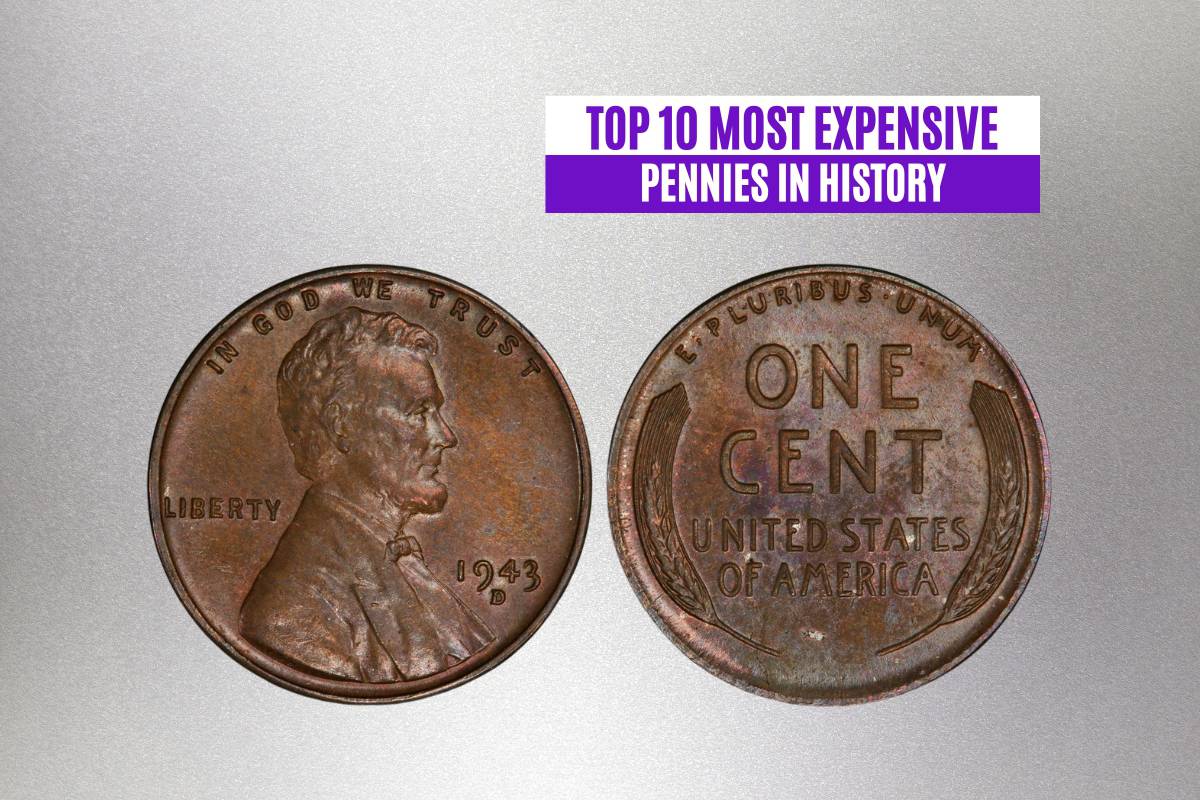The penny is the least valuable in-circulation U.S. coin, but it’s been associated with good luck and prosperity since its inception. But some pennies are bound to bring far more good fortune than others! After all, some of these one-cent coins sell for top-dollar prices.
The most expensive penny is the bronze 1943-D Lincoln Memorial cent. Although this error coin sold for $840,000 in 2021, its previous record-high selling price was a phenomenal $1.7 million, set in 2010. No other U.S. one-cent coin has sold for such high prices.
Although most pennies are only worth their listed denomination ($0.01), some are worth hundreds of thousands of dollars. This ranking will explore the priciest pennies in history.
Here Are the Top 10 Most Expensive Pennies in History:
- 1943-D Lincoln Wheat Cent (Bronze) – $1.7 million
- 1943-S Lincoln Wheat Cent (Bronze) – $504,000
- 1944-S Lincoln Wheat Cent (Steel) – $408,000
- 1943 Lincoln Wheat Cent (Bronze) – $372,000
- 1958 Lincoln Wheat Cent (Doubled Die Obverse) – $336,000
- 1909 VDB Lincoln Wheat Cent (Matte Proof) – $258,500
- 1856 Flying Eagle Cent (S-3, Proof) – $240,000
- 1943 Lincoln Wheat Cent (Struck on Bronze) – $218,500
- 1944 Lincoln Wheat Cent (Steel) – $180,000
- 1856 Flying Eagle Cent – $172,500
10. 1856 Flying Eagle Cent – $172,500
Grade: PCGS MS-66
Auction House: Heritage Auctions
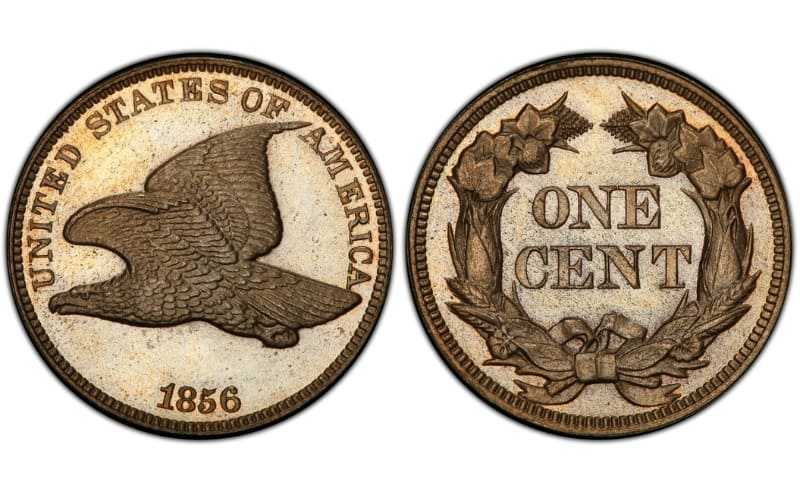
When most of us think about a penny, we think of a small copper-colored coin featuring the profile of President Abraham Lincoln. But Lincoln pennies didn’t enter circulation until 1909.
Before that time, one-cent coins had a variety of designs (and sizes). In fact, the very first U.S. pennies were much larger than the ones we know today. These coins were called large cents, and in 1856 they were replaced by the first “small cent” penny, the Flying Eagle cent.
This penny was about the same size as modern Lincoln pennies (19mm in diameter) and was made of 88% copper and 12% nickel. It featured a flying eagle (hence the name) on its obverse (front) side and a “ONE CENT” denomination marking surrounded by a wreath on its reverse (back) side.
However, the 1856 Flying Eagle cent wasn’t initially minted for circulation. Instead, it was designed and struck as a collectible coin meant only for numismatists and high-profile government officials.
Although the U.S. Mint initially only struck about 600 of these coins, up to 2,150 were eventually minted and distributed. Due to this limited supply, the 1856 Flying Eagle is easily one of the rarest and most desirable pennies ever created.
It’s not uncommon for these pennies to sell for thousands of dollars at auction, even when in comparatively poor condition.
The highest price ever paid for a regular strike 1856 Flying Eagle is $172,500. The particular coin in question was in stellar condition, with a PCGS grade of MS-66. It sold at auction in 2004.
Still, another 1856 Flying Eagle penny managed to outsell this cent in 2020. But we’ll touch on that in just a few moments.
9. 1944 Lincoln Wheat Cent (Steel) – $180,000
Grade: PCGS MS-64
Auction House: Heritage Auctions
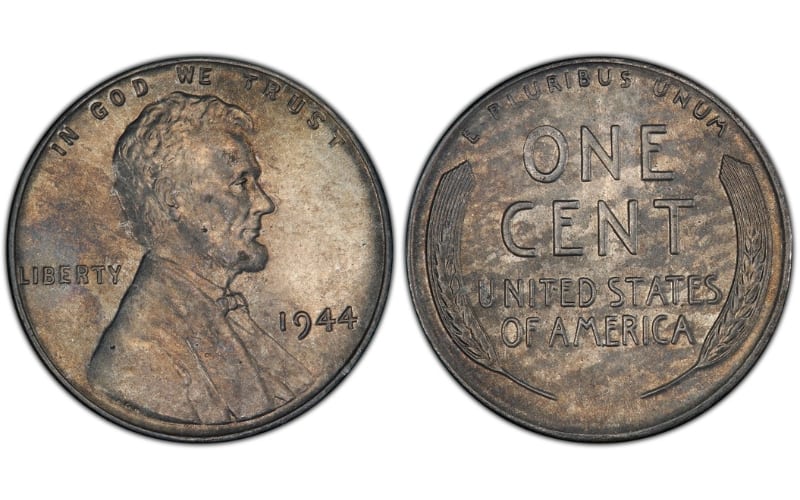
Wheat pennies are the first Lincoln cents, and they’re so-called because of the twin wheat stalks featured on their reverse sides. And although these pennies are typically only worth about $0.05 to $10, some can sell for jaw-dropping prices.
The steel 1944 Lincoln Wheat cent is a top-notch example.
This penny is an error coin, meaning that the U.S. Mint made an error when making it! During the 1940s, nearly all pennies were made of 95% copper and 5% zinc, a metal combination that gave pennies their iconic red-brown coloration.
But at some point, the Philadelphia Mint made a mistake while feeding metals through their mint-striking machinery, leading to the creation of distinctly silver-colored steel pennies.
It’s unknown precisely how many of these coins were struck before employees realized the error and fixed the mistake, but there are only 25 and 30 specimens. Few of these have withstood the test of time, making the rare few in tip-top mint condition exceptionally valuable.
An MS-64 1944 steel Lincoln Wheat cent sold for $180,000 when it went up for auction in 2021.
But, believe it or not, the Philadelphia Mint wasn’t the only mint facility that accidentally created pennies using the wrong type of metal. The San Francisco Mint also had its fair share of penny-minting problems.
8. 1943 Lincoln Wheat Cent (Struck on Bronze) – $218,500
Grade: PCGS AU-58
Auction House: Heritage Auctions
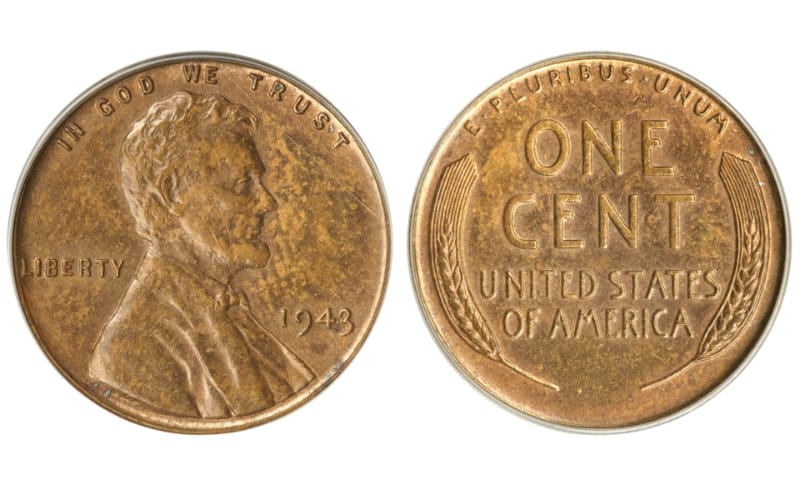
Although bronze and copper have near-identical hues, especially to the untrained eye, they’re very different metals with distinct properties.
That said, in 1943, some mint employees working at the San Francisco Mint facility confused the two, leading to the creation of the bronze 1943-S Lincoln Wheat cent.
During this time, the U.S. Mint had temporarily changed its procedure for producing pennies. Because of a copper shortage (caused by World War II), U.S. Mint facilities switched to making zinc-coated steel pennies.
This change only happened in 1943, with facilities switching back to copper and zinc by 1944. Due to this rapid change in procedure, all the operational U.S. Mint facilities had a few accidental alloy switch-ups in 1943.
But the San Francisco Mint bronze penny strike is one of the rarest, with less than two dozen known specimens. In 2010, one of these error coins (a slightly circulated specimen) sold for $218,500, making it more than 21 million times more valuable than its listed denomination!
Still, as you’ll soon find out, this bronze wartime penny isn’t the priciest error penny produced in 1943.
7. 1856 Flying Eagle Cent (S-3, Proof) – $240,000
Grade: PCGS PR-67+ CAC
Auction House: Heritage Auctions
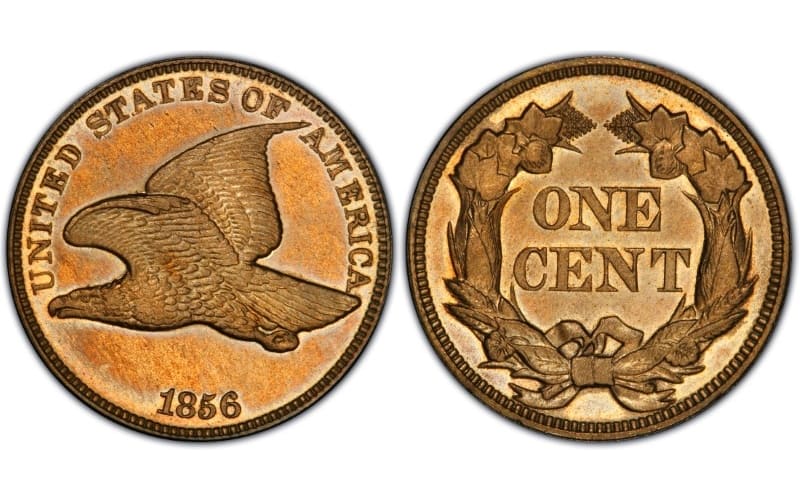
Proof coins from the mid-19th century are hard to come by nowadays, as most are part of esteemed coin collections. These high-quality specimens rarely ever go to auction due to their historical significance and exceptional condition.
But in 2020, a proof 1856 Flying Eagle cent did just that! 634 1856 Flying Eagle cents were identified as Snow-3 (S-3) variety and these coins were made for distribution to members of Congress for their approval.
This uncirculated piece looks brand-new thanks to lifetimes of careful storage and preservation, and it’s one of the few (if not the only) Flying Eagle penny to earn a coveted CAC (Certified Acceptance Corporation) sticker. Essentially, it’s a perfect penny.
When this Flying Eagle cent went to auction, it sold for an astounding $240,000, instantly making it the most valuable 1856 Flying Eagle cent in the world. Still, this beautiful coin isn’t the priciest (or rarest) penny.
6. 1909 VDB Lincoln Wheat Cent (Matte Proof) – $258,500
Grade: PCGS PR-67+
Auction House: Heritage Auctions
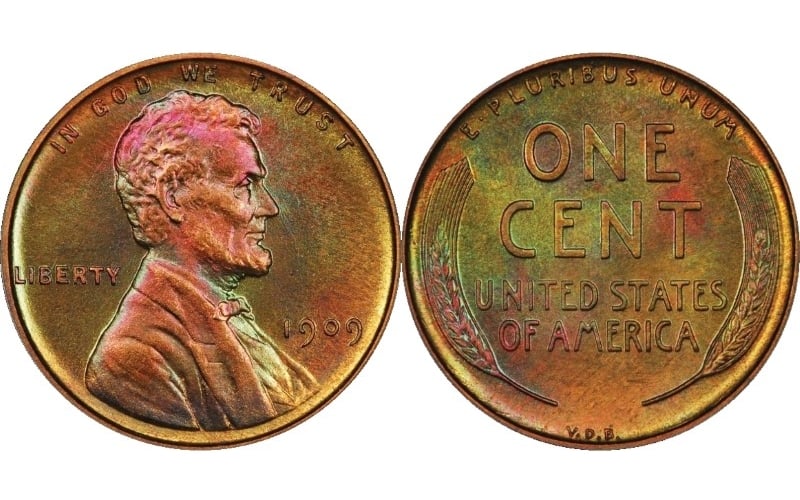
In 1909, the design for the U.S. one-cent coin changed. The previous iteration, the Indian Head cent, became the more familiar Lincoln cent. However, there was a distinct difference between these early Lincoln pennies and later iterations.
Namely, the reverse side of 1909 Lincoln Wheat cents featured a small set of initials: VDB.
These initials stand for Victor David Brenner, the man who designed the infamous and well-beloved Lincoln cent. But by 1910, these three little letters were gone from newly struck one-cent coins.
Consequently, high-quality VDB pennies can fetch a fortune at auction, as they’re highly prized by collectors.
The most valuable of these coins sold for $258,500 in 2014 and featured an incredible matte-proof finish that’s almost iridescent. No other VDB Lincoln Wheat cent is as fine as this one, which explains its unusually high selling price.
5. 1958 Lincoln Wheat Cent (Doubled Die Obverse) – $336,000
Grade: PCGS MS-64 RD
Auction House: Stack’s Bowers
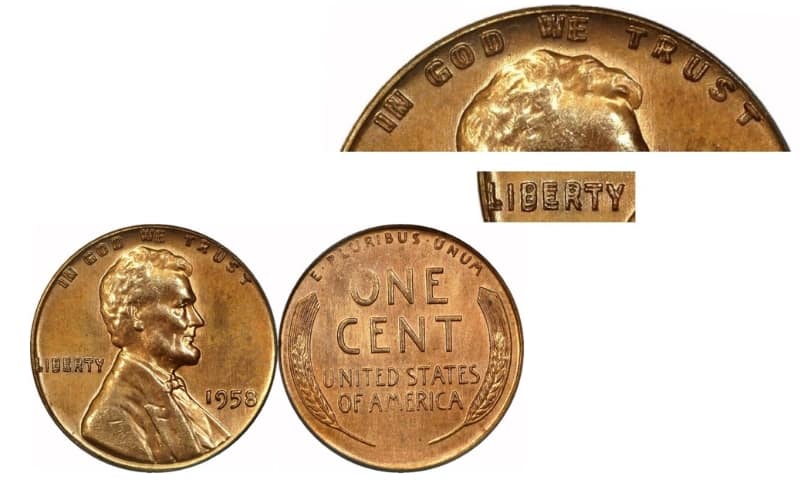
Wartime pennies and Flying Eagle cents are often the priciest one-cent U.S. coins. But there are a few exceptions, especially when it comes to unique error coins like the DDO 1958 Lincoln Wheat cent.
This error coin features a doubling of the obverse side design caused by a double pressing that was slightly offset from the original strike. This doubling is most noticeable along the motto at the top of the coin (“IN GOD WE TRUST”) and the motto at the leftmost side of the coin (“LIBERTY”).
For perspective, most DDO coins have doubling that’s barely discernible, looking almost error-free. Most of these coins require a keen eye to spot, and the subtlety of their errors makes them only slightly unusual.
But this DDO Lincoln Wheat cent is obvious; its motto errors make it stand out like a sore thumb. For this reason, it’s considered more valuable than other DDO pennies from the 1950s.
So, when this doubled die obverse coin went to auction in 2018, it sold for an astounding $336,000. Of course, it’s also crucial to mention that the coin was in great condition, earning a PCGS grade of MS-64 (mint state).
4. 1943 Lincoln Wheat Cent (Bronze) – $372,000
Grade: PCGS MS-62 BN
Auction House: Heritage Auctions
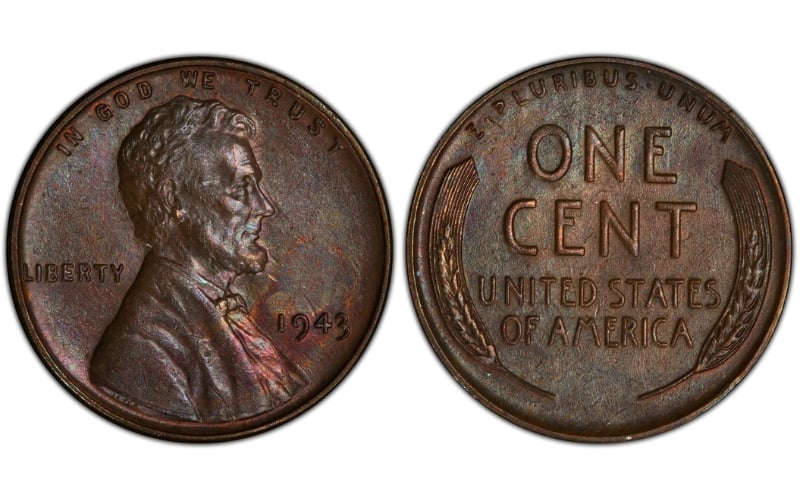
World War II started in 1939, and by the time 1943 rolled around, many of the Allied Nations were experiencing serious supply problems. The war effort demanded an incredible amount of metal for weapon production, leaving little leftover for domestic enterprises, including coin minting.
Consequently, the U.S. Mint switched from using bronze (a copper alloy) to zinc-coated steel when producing pennies in 1943. However, like the San Francisco Mint, the Philadelphia Mint facility had a few slip-ups when ensuring that only steel entered the coin production areas.
That’s how we ended up with the iconic bronze 1943 Lincoln Wheat cent.
It’s unclear how many of these red-brown pennies left the Philadelphia Mint, as they’re all error coins. Most were probably scrapped and melted down before leaving the facility, with only a handful actually entering circulation.
That said, PCGS has graded several of the rare bronze wartime pennies, with the highest-quality specimen being a mint state coin that sold for $372,000 in 2021.
But, as you might imagine, switching to zinc-coated steel planchets (smooth metal discs used for coin-making) for a single year can lead to quite a few mix-ups. Many U.S. Mint facilities experienced production errors not only in 1943 but in the following year as well.
3. 1944-S Lincoln Wheat Cent (Steel) – $408,000
Grade: PCGS MS-66
Auction House: Heritage Auctions
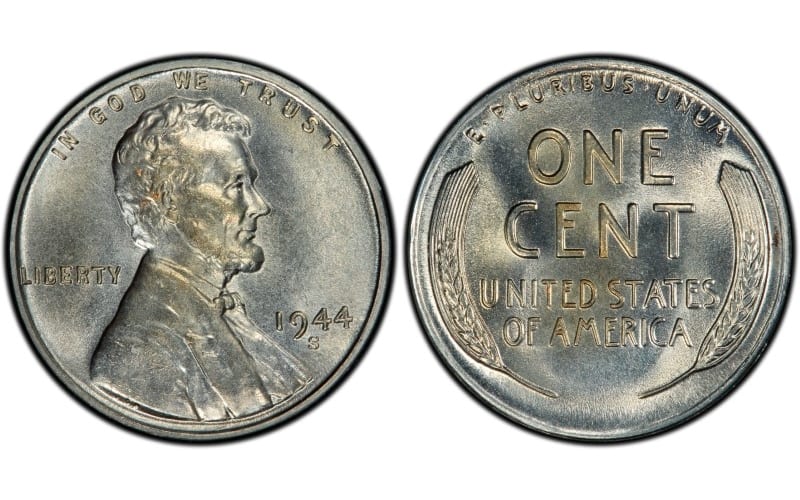
One can only imagine how frustrating life must have been for U.S. Mint employees working in facilities throughout the early 1940s. In 1943 the order came through to switch to steel planchets, and then only about a year later, that order was reversed!
As we’ve established, the Philadelphia Mint facility ended up producing some after-the-fact steel pennies in 1944. But it wasn’t the only facility to do so. During the same year, the San Francisco Mint also pumped out some silver-colored Lincoln Wheat cents.
But unlike the zinc-coated steel pennies from the Philadelphia Mint, San Francisco Mint steel pennies struck in 1944 are exceptionally rare. We’re talking “only two specimens” level of rarity.
The reason behind this scarcity of steel 1944 San Francisco pennies is unclear. Still, it’s likely that the facility employees caught the problem early on and destroyed most of the error specimens before they entered circulation.
One of these coins (an XF-40) sold for $49,200 in 2018. But a higher-quality, better-condition specimen (an MS-66) sold for $408,000 in 2021. This MS-66 1944-S Lincoln Wheat cent is the only mint example in existence.
2. 1943-S Lincoln Wheat Cent (Bronze) – $504,000
Grade: PCGS MS-63 BN
Auction House: Heritage Auctions
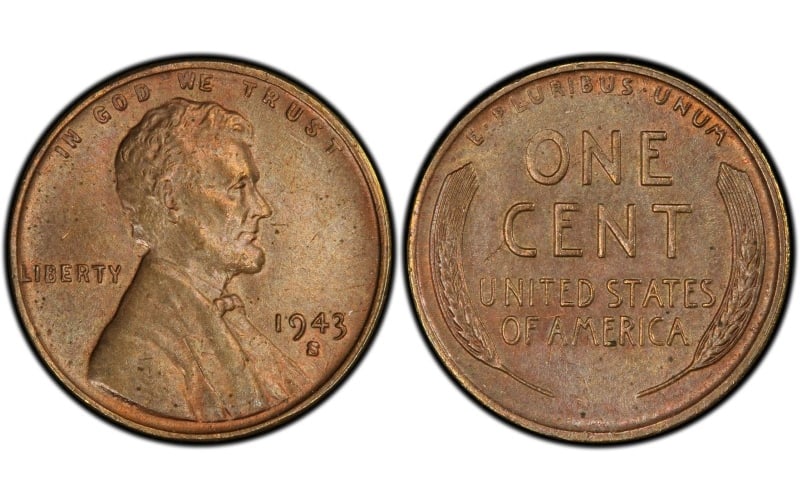
The second-most expensive penny is the iconic bronze 1943-S Lincoln Wheat cent. Sure, a circulated version of this error penny sold for $218,500 back in 2010, but it couldn’t hold a candle to the MS-63 (mint state) uncirculated version that went to auction in 2020.
This one-cent coin fetched an astounding $504,000! But considering the fact that it’s only one of six known examples and the finest of the bunch, this high price is somewhat unsurprising.
Still, this coin’s usually high auction price is less than half of the price of the priciest penny of them all: the 1943-D Lincoln
1. 1943-D Lincoln Wheat Cent (Bronze) – $1.7 Million
Grade: PCGS MS-64 BN
Auction House: N/A (Private Sale)
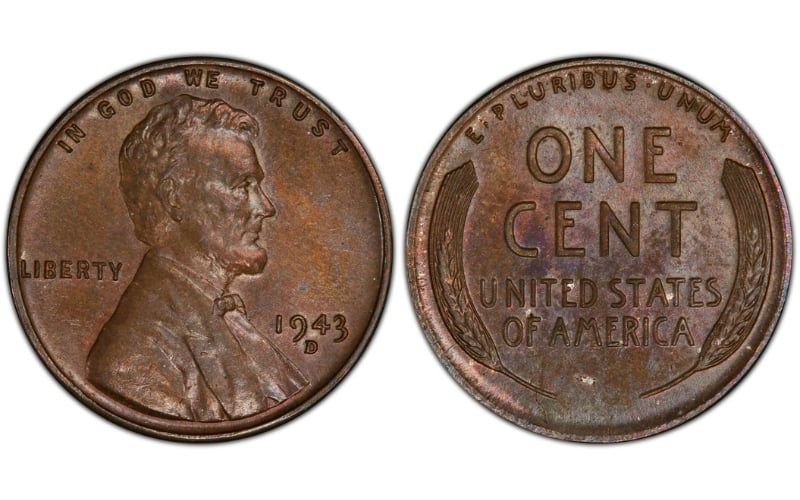
The most expensive penny is the 1943-D Lincoln Wheat cent, a bronze error coin that sold for $1.7 million in 2010. Even though this coin sold for a smaller sum ($840,000) in 2021, it remains the priciest penny of all time.
The reasons behind this wheat penny’s high auction price are pretty straightforward.
Firstly, this is an error penny. Created during the height of World War II, this penny should have been made of zinc-coated steel. Instead, it was made of bronze, a precious copper alloy in scarce supply at the time.
Secondly, this penny was struck at the Denver Mint, which produced far fewer pennies than the Philadelphia Mint and San Francisco Mint in 1943. In fact, the bronze 1943-D Lincoln Wheat penny is the only one of its kind.
Instead of stemming from widespread production issues (like using the wrong planchets), this coin was likely a secret creation of a Denver Mint employee. But no matter the true story of how this coin came to be, at least one thing is for sure; it’s the most valuable penny in the world!
What’s the Most Expensive Penny?
The most expensive penny of all time is the bronze 1943-D Lincoln Memorial cent. This coin was struck in bronze by mistake and is a one-of-a-kind piece.
In 2021, this coin sold for $840,000. But in 2010, it sold for a far more impressive $1.7 million. Either way, no other penny has sold for such high prices as this one.
Learn more about the world’s most expensive lifestyles and products by checking out these related articles now!

